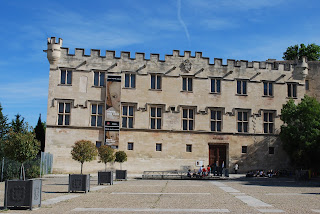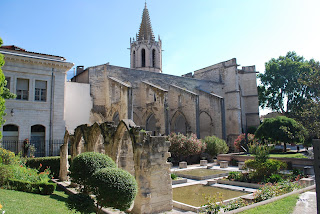Avignon lies on the west bank of the River Rhone. The city is famous for two things: the bridge that does not span the river, and the Palace of the Popes.
The bridge is older than the palace. It was constructed in the 12th century by Saint Benezet (the Provencal version of the name "Benedict"), a humble shepherd boy who, according to legend, heard angelic voices calling him to go to Avignon and build a bridge. Work began in 1177 and was completed eight years later.
The picture below gives a misleading impression of the vast scale of the project. What appears to be the far bank is in fact a long, narrow island in the middle of the Rhone, which did not exist in the 12th century. In fact the bridge ran all the way to the white tower seen on the right: almost a thousand yards long, with 22 arches, running in an S-shaped curve so as to base the piers on avialable shoals of gravel in the river bed.
The tower is all that remains of a castle built by Philip IV of France (Philippe le Bel) in 1302, to control the river crossing. We will meet him again shortly.
The bridge today provides a fine view of the provided there are not too many crowds of tourists!
On the left of this picture is the Jardin du Rocher des Doms, a delightful wooded hilltop, from which there are splendid views eastwards to the bridge (as in the first picture) and south over the Cathedral of Notre Dame des Doms and the Palace of the Popes.
The cathedral was first built around 1140.
The gilded statue of the Virgin was placed on top of the tower in the 19th century. This is the west door
After a bitter conflict between the Papacy and King Philip IV, the Archbishop of Bordeaux was elected as Pope Clement V in 1305. He never went to Rome, and for the next 68 years all the Popes were Frenchmen. They built in Avignon the Palace of the Popes, which grew to be the largest building of its kind in western Europe. They lived in great luxury, which appalled and disgusted Petrach when he visited Avignon.
In 1417 the Popes returned to Rome, but Avignon remained papal territory. Only with the French Revolution did the city become part of France, and the Palace of the Popes was then occupied and plundered and used as a barracks. No furniture survives, and of the lavsh decorations, only a couple of chapels
and a few of the Pope's private rooms.
However, nowadays you can be taken on a "virtual reality" tour of the Palace, where the furniture and decoration of all the main rooms is recreated for you. This will take probably a couple of hours, but it is time well spent.
Facing the papal palace is the baroque Hotel des Monnaies
The Petit Palais, nearby, was remodelled in Renaissance style by Cardinal della Rovere, who later became Pope Julius II.
Nowadays it contains a splendid museum and gallery, featuring Italian religious art of Julius II's period: the late 15th and early 16th centuries.
There are several other museums, which I didn't have time to visit. The Musee Calvet on the Rue Josef Vernet is said to be particularly good.
The old city of Avignon is surrounded by its mediaeval walls and gates, but a modern boulevard has been blasted through from the Place de l'Horloge, where stands the Hotel de Ville and the Second Empire theatre,
and runs southwards to the railway station. At the northern end, where it is called the Rue de la Republique, it is lined with open-air restaurants of all kinds; and further on, when it become the Cours Jean Jaures, you will find the main shops. To the west of the boulevard there is still a maze of narrow streets, where there are a great many small restaurants, shops, churches and museums.
Interestingly, an attempt is being made to revive the local Provencal tongue, with dual-language street names.
There is also a splendid modern building, les Halles (the market), with a green ecological exterior.
A good way of seeing Avignon is to board the little street-train for tourists, which departs from near the papal palace. The trip round the streets takes about 45 minutes, with a multilingual commentary, and I thought it was good value.
























Thanks for sharing excellent information's. Your web-site is very cool. I'm impressed by the details that you have on this web site.
ReplyDeletelampedusa natura